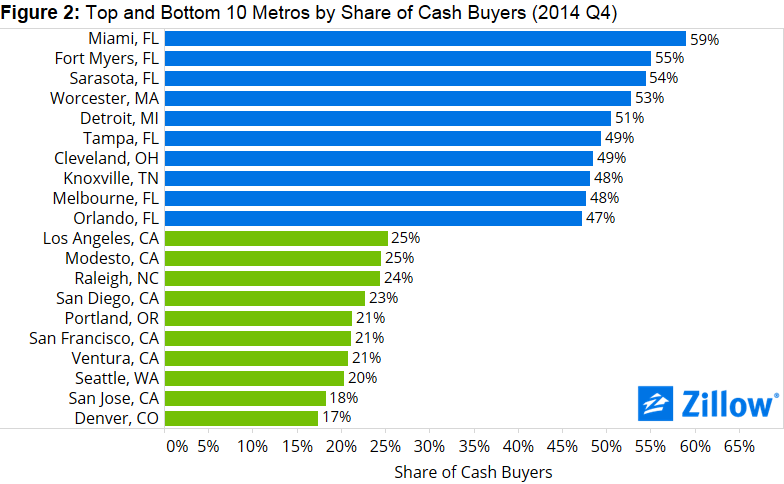- Six of the top 10 metros with the highest share of cash buyers are in Florida.
- Six of the top 10 metros with the lowest share of cash buyers are in California.
When most people think of buying a home, they typically think of getting a mortgage to help pay for it. But getting a mortgage isn’t the only way to buy a home – cash is still very much king in dozens of markets nationwide.
Markets west of the Mississippi River have smaller shares of cash purchases, while markets east of the Mississippi are a mixed bag – with the exception of Florida, where king cash reigns supreme (figure 1).
As of Q4 2014, six of the top 10 metros with the largest shares of cash purchases are in Florida (figure 2). These metros feature large numbers of retired home buyers, who may be more likely to sell their previous home and use the proceeds to purchase their new home without a mortgage.
Of the non-Florida metros with large shares of cash buyers – including Detroit (2.2), Knoxville (2.8) and Cleveland (3) – most feature a price-to-income ratio well below the national average of 3.3. The price-to-income ratio measures the price of a home relative to the typical annual income in an area. For example, if the typical household takes in $50,000 per year in income, and the average home in their market costs $100,000, the price-to-income ratio would be 2 ($100,000/$50,000).
 Price-to-income can be a good measure of how affordable a given market is relative to others. It can be easier to purchase a home with all cash in markets with low price-to-income ratios, since it can take less time to save the money needed to make the cash purchase than it would be in places with higher ratios.
Price-to-income can be a good measure of how affordable a given market is relative to others. It can be easier to purchase a home with all cash in markets with low price-to-income ratios, since it can take less time to save the money needed to make the cash purchase than it would be in places with higher ratios.
Despite their shared coastal locations and lifestyles, California is the opposite of Florida when it comes to cash buyers – six of the 10 metros with the lowest share of cash buyers are in California. This makes sense, since homes in California metros are typically extremely expensive relative to incomes. Santa Cruz features the highest price-to-income ratio in the country, at 9.1. Los Angeles is not far behind, with a price-to-income ratio of 8.8.
*Thank Randy Moss for the headline inspiration.